light Lancia Delta 2011 Owner handbook (in English)
[x] Cancel search | Manufacturer: LANCIA, Model Year: 2011, Model line: Delta, Model: Lancia Delta 2011Pages: 290, PDF Size: 8.36 MB
Page 219 of 290
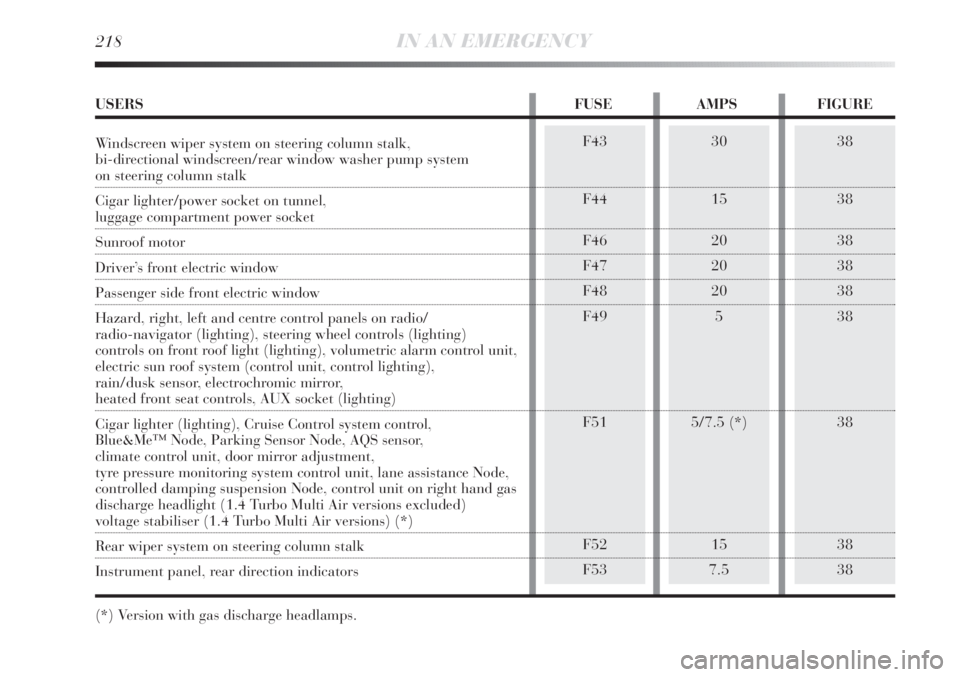
218IN AN EMERGENCY
38
38
38
38
38
38
38
38
38F43
F44
F46
F47
F48
F49
F51
F52
F5330
15
20
20
20
5
5/7.5 (*)
15
7.5
USERS FUSE AMPS FIGURE
Windscreen wiper system on steering column stalk,
bi-directional windscreen/rear window washer pump system
on steering column stalk
Cigar lighter/power socket on tunnel,
luggage compartment power socket
Sunroof motor
Driver’s front electric window
Passenger side front electric window
Hazard, right, left and centre control panels on radio/
radio-navigator (lighting), steering wheel controls (lighting)
controls on front roof light (lighting), volumetric alarm control unit,
electric sun roof system (control unit, control lighting),
rain/dusk sensor, electrochromic mirror,
heated front seat controls, AUX socket (lighting)
Cigar lighter (lighting), Cruise Control system control,
Blue&Me™ Node, Parking Sensor Node, AQS sensor,
climate control unit, door mirror adjustment,
tyre pressure monitoring system control unit, lane assistance Node,
controlled damping suspension Node, control unit on right hand gas
discharge headlight (1.4 Turbo Multi Air versions excluded)
voltage stabiliser (1.4 Turbo Multi Air versions) (*)
Rear wiper system on steering column stalk
Instrument panel, rear direction indicators
(*) Version with gas discharge headlamps.
Page 220 of 290
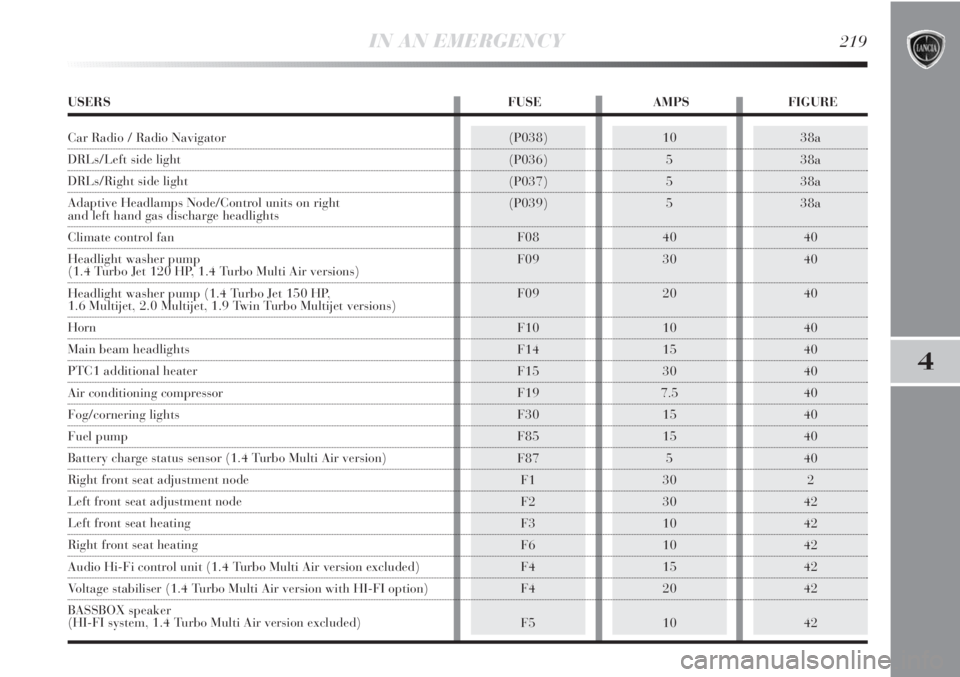
IN AN EMERGENCY219
4
38a
38a
38a
38a
40
40
40
40
40
40
40
40
40
40
2
42
42
42
42
42
42(P038)
(P036)
(P037)
(P039)
F08
F09
F09
F10
F14
F15
F19
F30
F85
F87
F1
F2
F3
F6
F4
F4
F510
5
5
5
40
30
20
10
15
30
7.5
15
15
5
30
30
10
10
15
20
10
USERS FUSE AMPS FIGURE
Car Radio / Radio Navigator
DRLs/Left side light
DRLs/Right side light
Adaptive Headlamps Node/Control units on right
and left hand gas discharge headlights
Climate control fan
Headlight washer pump
(1.4 Turbo Jet 120 HP, 1.4 Turbo Multi Air versions)
Headlight washer pump (1.4 Turbo Jet 150 HP,
1.6 Multijet, 2.0 Multijet, 1.9 Twin Turbo Multijet versions)
Horn
Main beam headlights
PTC1 additional heater
Air conditioning compressor
Fog/cornering lights
Fuel pump
Battery charge status sensor (1.4 Turbo Multi Air version)
Right front seat adjustment node
Left front seat adjustment node
Left front seat heating
Right front seat heating
Audio Hi-Fi control unit (1.4 Turbo Multi Air version excluded)
Voltage stabiliser (1.4 Turbo Multi Air version with HI-FI option)
BASSBOX speaker
(HI-FI system, 1.4 Turbo Multi Air version excluded)
Page 226 of 290
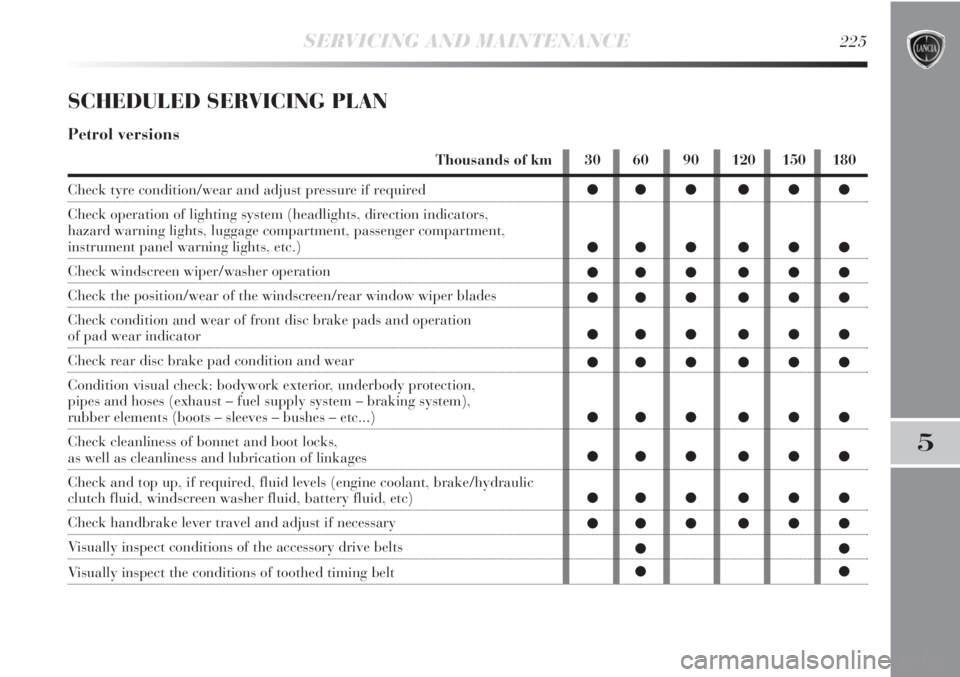
30 60 90 120 150 180
●●● ●●●
●●● ●●●
●●● ●●●
●●● ●●●
●●● ●●●
●●● ●●●
●●● ●●●
●●● ●●●
●●● ●●●
●●● ●●●
●●
●●
SERVICING AND MAINTENANCE225
5
SCHEDULED SERVICING PLAN
Petrol versions
Thousands of km
Check tyre condition/wear and adjust pressure if required
Check operation of lighting system (headlights, direction indicators,
hazard warning lights, luggage compartment, passenger compartment,
instrument panel warning lights, etc.)
Check windscreen wiper/washer operation
Check the position/wear of the windscreen/rear window wiper blades
Check condition and wear of front disc brake pads and operation
of pad wear indicator
Check rear disc brake pad condition and wear
Condition visual check: bodywork exterior, underbody protection,
pipes and hoses (exhaust – fuel supply system – braking system),
rubber elements (boots – sleeves – bushes – etc...)
Check cleanliness of bonnet and boot locks,
as well as cleanliness and lubrication of linkages
Check and top up, if required, fluid levels (engine coolant, brake/hydraulic
clutch fluid, windscreen washer fluid, battery fluid, etc)
Check handbrake lever travel and adjust if necessary
Visually inspect conditions of the accessory drive belts
Visually inspect the conditions of toothed timing belt
Page 228 of 290
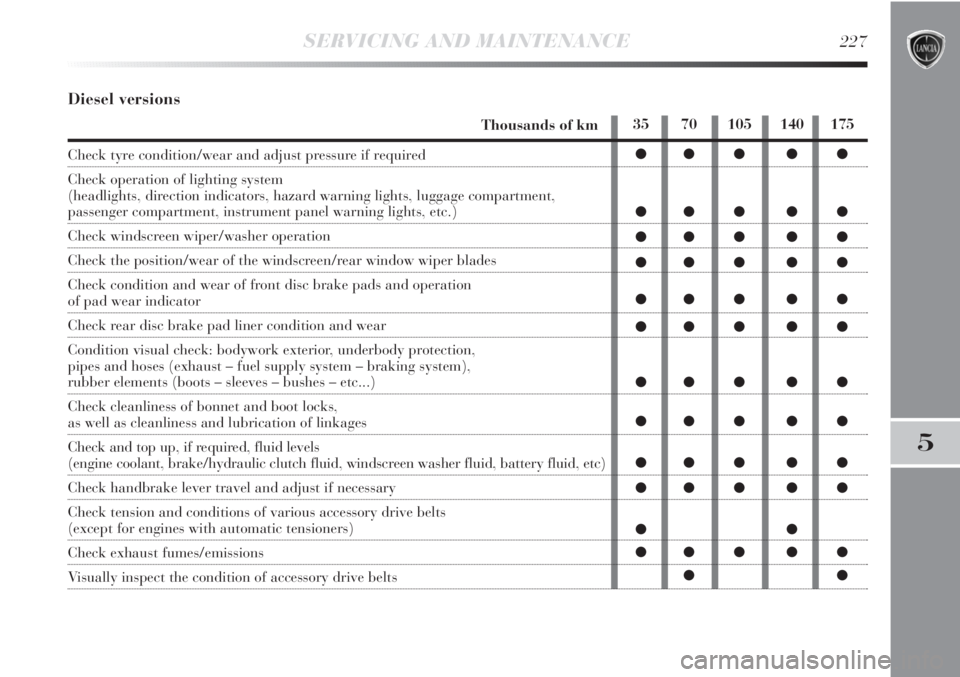
SERVICING AND MAINTENANCE227
5
35 70 105 140 175
●● ● ● ●
●● ● ● ●
●● ● ● ●
●● ● ● ●
●● ● ● ●
●● ● ● ●
●● ● ● ●
●● ● ● ●
●● ● ● ●
●● ● ● ●
●●
●● ● ● ●
●●
Diesel versions
Thousands of km
Check tyre condition/wear and adjust pressure if required
Check operation of lighting system
(headlights, direction indicators, hazard warning lights, luggage compartment,
passenger compartment, instrument panel warning lights, etc.)
Check windscreen wiper/washer operation
Check the position/wear of the windscreen/rear window wiper blades
Check condition and wear of front disc brake pads and operation
of pad wear indicator
Check rear disc brake pad liner condition and wear
Condition visual check: bodywork exterior, underbody protection,
pipes and hoses (exhaust – fuel supply system – braking system),
rubber elements (boots – sleeves – bushes – etc...)
Check cleanliness of bonnet and boot locks,
as well as cleanliness and lubrication of linkages
Check and top up, if required, fluid levels
(engine coolant, brake/hydraulic clutch fluid, windscreen washer fluid, battery fluid, etc)
Check handbrake lever travel and adjust if necessary
Check tension and conditions of various accessory drive belts
(except for engines with automatic tensioners)
Check exhaust fumes/emissions
Visually inspect the condition of accessory drive belts
Page 229 of 290

228SERVICING AND MAINTENANCE
Thousands of km
Check engine control system operation (using diagnosis socket)
Check battery charge status and possibly recharge
Replace accessory drive belts
Replace toothed timing drive belt (*)
Replace fuel filter
Replace air filter cartridge
Change engine oil and oil filter (versions without DPF) (or every 24 months)
Change engine oil and oil filter (versions with DPF) (**)
Change brake fluid (or every 24 months)
Change pollen filter (or every 15 months)
(*) Regardless of the distance covered, the timing belt must be changed every 4 years for particularly demanding use (cold cli-
mates, city driving, long periods of idling) or at least every 5 years.
(**) The engine oil and oil filter should be changed when the warning light on the dashboard comes on, or every 24 months.
If the car is mainly used in towns and cities, change the engine oil and filter every 12 months.
35 70 105 140 175
●● ● ● ●
●● ● ● ●
●
●
●●
●●
●● ● ● ●
●●
●● ● ● ●
Page 230 of 290
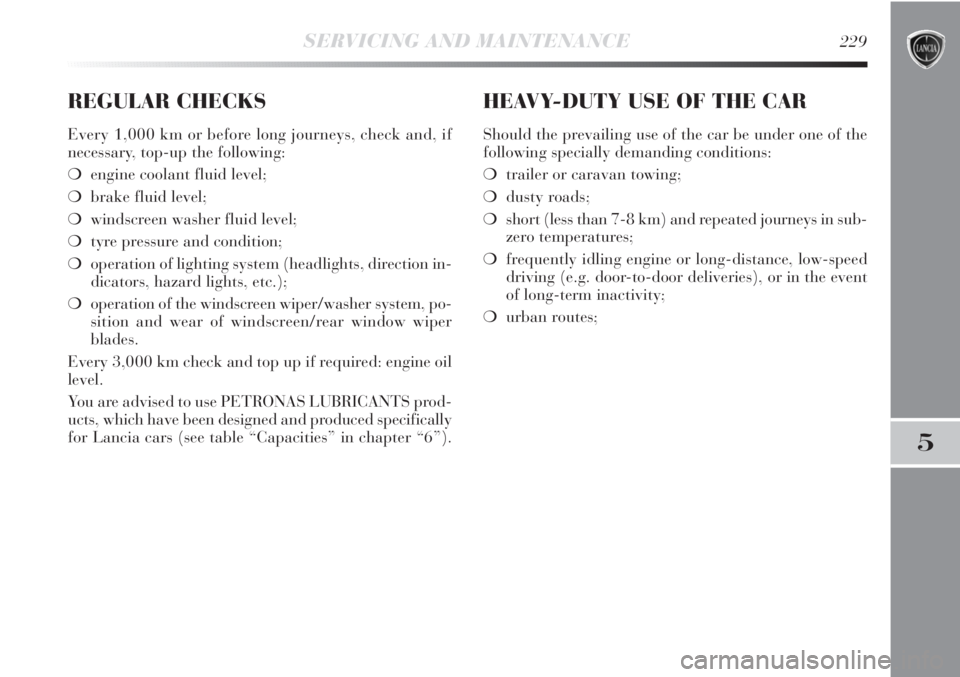
SERVICING AND MAINTENANCE229
5
REGULAR CHECKS
Every 1,000 km or before long journeys, check and, if
necessary, top-up the following:
❍engine coolant fluid level;
❍brake fluid level;
❍windscreen washer fluid level;
❍tyre pressure and condition;
❍operation of lighting system (headlights, direction in-
dicators, hazard lights, etc.);
❍operation of the windscreen wiper/washer system, po-
sition and wear of windscreen/rear window wiper
blades.
Every 3,000 km check and top up if required: engine oil
level.
You are advised to use PETRONAS LUBRICANTS prod-
ucts, which have been designed and produced specifically
for Lancia cars (see table “Capacities” in chapter “6”).
HEAVY-DUTY USE OF THE CAR
Should the prevailing use of the car be under one of the
following specially demanding conditions:
❍trailer or caravan towing;
❍dusty roads;
❍short (less than 7-8 km) and repeated journeys in sub-
zero temperatures;
❍frequently idling engine or long-distance, low-speed
driving (e.g. door-to-door deliveries), or in the event
of long-term inactivity;
❍urban routes;
Page 240 of 290

SERVICING AND MAINTENANCE239
5
BATTERY
The car is fitted with a low-maintenance battery, F-fig.
1-2-3-4: no top-ups with distilled water are needed in
standard conditions of use.
It does need to be checked regularly at a Lancia Dealer-
ship or by specialist personnel to make sure that it is
working properly.
Battery liquid is poisonous and corrosive.
Avoid contact with the skin and eyes. Keep
naked flames or possible sources of sparks
away from the battery: risk of explosion or fire.
Using the battery when the fluid is too low
can damage it irreparably and generate
a risk of explosion.
CHANGING THE BATTERY
If required, replace the battery with a genuine spare part
with the same specifications.
If a battery with different specifications is fitted, the ser-
vice intervals given in the “Scheduled Servicing Pro-
gramme” in this chapter will no longer be valid.
Follow the battery manufacturer’s instructions for main-
tenance.
Advanced ESP system
If the battery is disconnected, the warning light
áwill
switch on (together with a message in the display) to in-
dicate that the system must be realigned. To switch the
warning light off, carry out the following initialisation
procedure:
❍turn the ignition key to MAR:
❍turn the steering wheel fully both clockwise and anti-
clockwise (to move from the position with the wheels
straight);
❍turn the ignition key to STOP and then to MAR.
If the warning light ádoes not go out after a few seconds,
seek assistance from a Lancia Dealership.
Page 242 of 290

SERVICING AND MAINTENANCE241
5
USEFUL ADVICE FOR EXTENDING
THE LIFE OF YOUR BATTERY
To avoid draining your battery and make it last longer,
observe the following instructions:
❍when you park the car, ensure the doors, tailgate and
bonnet are closed properly, to prevent any light from
remaining on inside the passenger’s compartment;
❍turn off the roof lights, although the car does have an
automatic system for switching off internal lights;
❍do not leave devices (e.g. car radio, hazard lights, etc.)
switched on for a long time when the engine is not
running;
❍before performing any operation on the electrical sys-
tem, disconnect the negative battery cable;
❍battery terminals should always be perfectly tight-
ened.
IMPORTANT If the charge level remains under 50% for
a long time, the battery is damaged by sulphation, re-
ducing its capacity and starting attitude.The battery will also be more at risk of freezing (this can
happen as early as −10 °C). In the case of prolonged idle-
ness, refer to the paragraph “Car inactivity”, in chapter
“3”.
If you decide to install electrical accessories after the car
has been purchased which require a permanent electric
power supply (alarm, etc.) or accessories which have
a serious impact on the electrical balance, seek assistance
from a Lancia Dealership because their qualified staff will
suggest the most suitable Lancia Lineaccessori devices
and assess the overall electric consumption, checking
whether the car’s electrical system can cope or whether
a more powerful battery is required.
Since these devices continue to consume energy even when
the engine is off, they gradually run down the battery.
Page 249 of 290

248SERVICING AND MAINTENANCE
Dry the less visible parts particularly carefully, such as
the door frames, bonnet and the headlight frames, where
water may stagnate more easily. The car should not be
taken to a closed area immediately, but left outside so that
residual water can evaporate.
Do not wash the car after it has been left in the sun or
with the bonnet hot: this may alter the shine of the paint-
work.
Exterior plastic parts must be cleaned in the same way as
the rest of the car.
Where possible, do not park under trees; the resinous
substance that many species release give the paint a dull
appearance and increase the possibility of triggering rust-
ing processes. ADVICE FOR PRESERVING THE BODYWORK
Paint
Paintwork does not only serve an aesthetic purpose, but
also protects the underlying sheet metal.
Touch up abrasions and scratches immediately to prevent
rust formation. Use only original paint products for
touch-ups (see “Bodywork paint identification plate” in
the “Technical specifications” section).
Normal maintenance of paintwork consists in washing
the car: the frequency depends on the conditions and en-
vironment where the car is used. For example, in highly
polluted areas, or if the roads are sprayed with salt, it is
wise to wash the car more frequently.
To correctly wash the vehicle, proceed as follows:
❍if taking your car through an automatic car wash, re-
move the aerial from the roof to avoid damaging it;
❍in washing stations keep the steam jet/high pressure
washing nozzles at least 40 cm away from the body-
work to prevent damage. It should be remembered
that the build up of water can damage the car over
a period of time;
❍wash the body using a low pressure jet of water;
❍wipe a sponge with a slightly soapy solution over the
bodywork, frequently rinsing the sponge;
❍rinse well with water and dry with a jet of air or a
chamois leather.
Page 250 of 290

SERVICING AND MAINTENANCE249
5
Hard Black versions
Detergents pollute the environment. Only
wash the car in areas equipped for the col-
lection and purification of the fluids used in
the washing process.
Glasses
To clean glasses, use specific window cleaner products.
Also use clean cloths to avoid scratching the glass or dam-
aging the transparency.
IMPORTANT Wipe the rear window inside gently with
a cloth in the direction of the filaments to avoid damag-
ing the heating device.
Engine compartment
At the end of each winter, thoroughly wash the engine
compartment, taking care to avoid spraying the water jet
directly onto the electronic control units and the re-
lay/fuse control unit on the left side of the engine com-
partment (as you look from behind the wheel). Have this
operation performed at a specialised workshop.
IMPORTANT The washing should take place with the en-
gine cold and the ignition key in the STOP position. Af-
ter the washing operation, make sure that the various
protections (e.g. rubber caps and guards) have not been
removed or damaged.
Front headlights
IMPORTANT Never use aromatic substances (e.g.:
petrol) or ketones (e.g.: acetone) for cleaning the front
headlight plastic lenses.
In order to preserve the aesthetic appearance
of the paintwork abrasive products and/or pol-
ishes should not be used for cleaning the car.
IMPORTANT Bird droppings must be washed off imme-
diately and carefully as the acid they contain is particu-
larly aggressive.
It is recommended to avoid washing with
rollers and/or brushes in car wash stations.
Thus, wash the car only by hands using neu-
tral pH detergents; dry it with a wet chamois leather.
Abrasive products and/or polishes should not be used
for cleaning the car. Bird droppings must be washed
off immediately and thoroughly as the acid they con-
tain is particularly aggressive. Avoid (if possible) to
park your car under trees; remove immediately veg-
etable resins as, when dried, they could only be re-
moved with abrasive products and/or polishes that
are not recommended as they could possibly alter the
typical paint opacity. Do not use pure windscreen
washer fluid for cleaning the front windscreen and
rear screen; dilute it min. 50% with water.